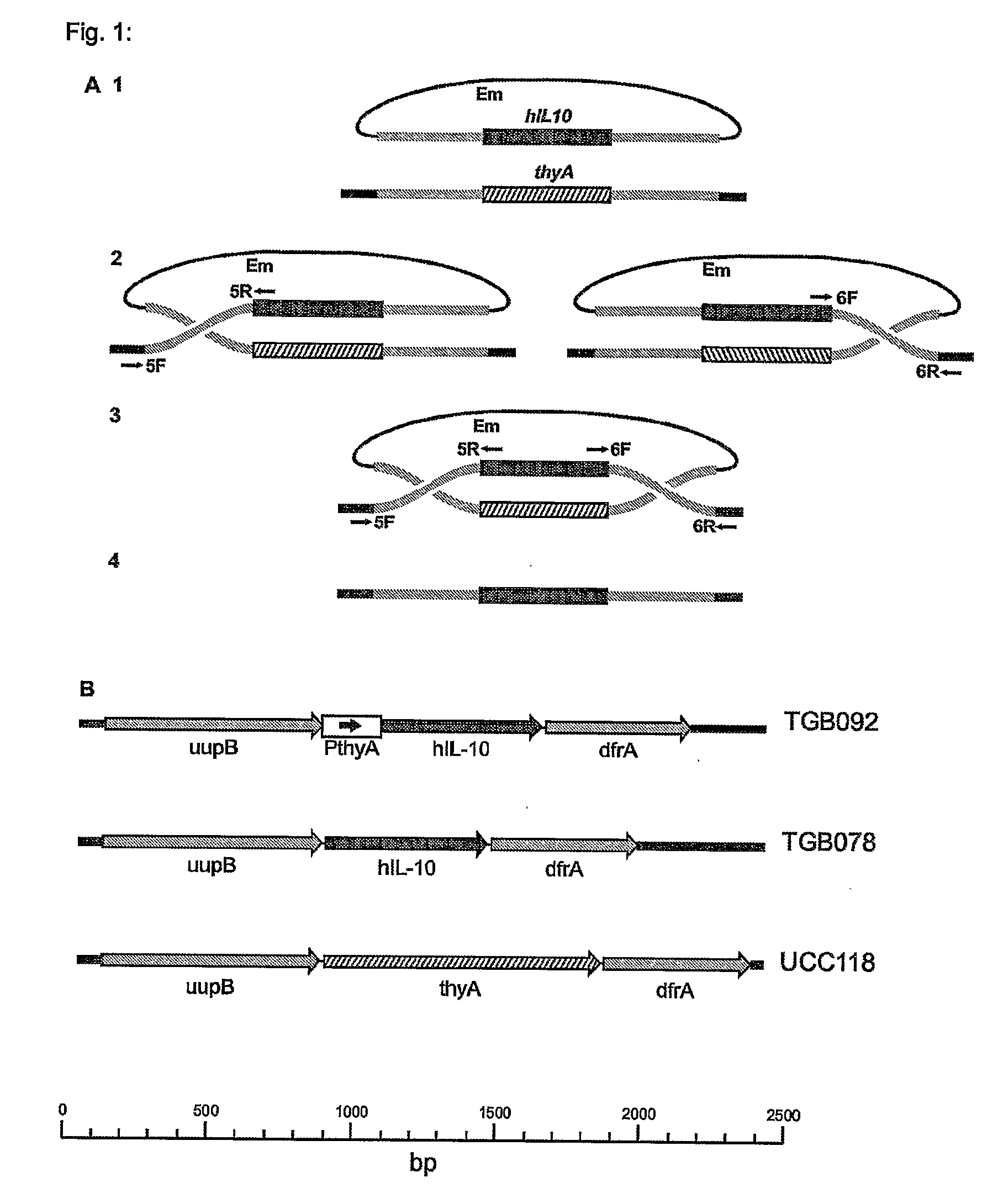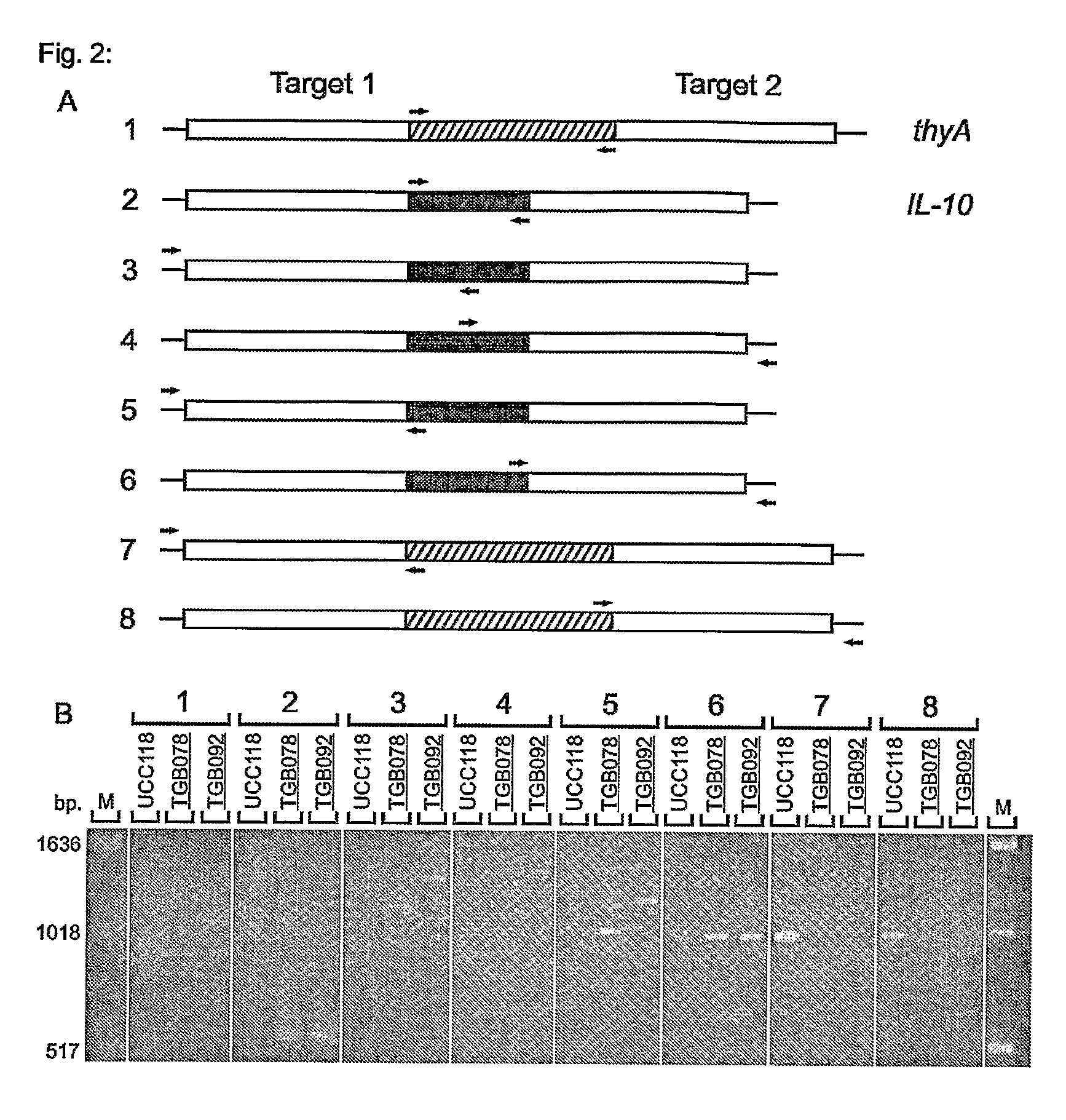Self-Containing Lactobacillus Strain
a technology of lactobacillus and self-contained bacteria, which is applied in the direction of biocide, enzymes, non-active ingredients in the pharmaceutical field, can solve the problems of reducing the possibility of survival of genetically modified microorganisms in the environment, surviving and spreading in the environment, etc., and achieves the effect of better containmen
- Summary
- Abstract
- Description
- Claims
- Application Information
AI Technical Summary
Benefits of technology
Problems solved by technology
Method used
Image
Examples
example 2
Identification of a thyA− and IL-10+ Lactobacillus
[0064]Primary thya− and IL-10+ Confirmation by PCR
[0065]The primary confirmation of the Lactobacillus colonies carrying a hIL-10 insert was done by PCR testing, as presented in FIG. 2. Several sets of primers were used for the detection of thyA (FIG. 2, PCR1) of IL-10 (FIG. 2, PCR2) of the flanking sequences of IL-10 (FIG. 2, PCR3 through PCR6) and of the flanking sequences of thyA (FIG. 2, PCR7 and PCR8).
[0066]The results show clearly that in the mutant strains TGB072 and TGB092, the coding sequence of thyA has been replaced by the human IL-10 sequence.
TABLE 1primers usedSEQ IDSEQ IDPCRForwardNO:ReverseNO:1CTATAGTAGAAGAACCGTATTTAC1CAGCAACTGGCGCTTTAATTGC92GATTATCTCAGCTATTTTAATGTC2CGGATTTTCATAGTCATGTAAG103TTTAGGACAACAAAGATTGGG3GCATCACGCAAATCACGAAG114CTTCGTGATTTGCGTGATGC4GTCTTATTAAAGGAAGCAATTGC125TTTAGGACAACAAAGATTGGG5GACATTAAAATAGCTGAGATAATC136CTTACATGACTATGAAAATCCG6GTCTTATTAAAGGAAGCAATTGC147TTTAGGACAACAAAGATTGGG7GTAAATACGGTTCTTCTACT...
example 3
Production of Human IL-10 by the thyA− and IL-10+ Lactobacillus
[0068]To evaluate the hIL-10 secretion, single colonies of each strain were grown in MRS supplemented with 50 μg / ml thymidine. After 40 hours of growth at 37° C., the bacteria were harvested by centrifugation and resuspended in buffered M9 (BM9) supplemented with 50 μg / ml thymidine. The suspension was incubated for five hours at 37° C., and then the prevalence of human IL-10 was determined by ELISA (Becton Dickinson). The results are summarized in FIG. 4. Both strains comprising the human IL-10 coding sequence do produce IL-10, but the production is far higher when the human IL-10 coding sequence is operably linked to the Lactococcus lactis thyA promoter. Although the production of hIL-10 is lower than what is described for Lactococcus lactis (Steidler et al., 2003), the amount is sufficiently high to be effective in vivo for the treatment of chronic intestinal inflammation.
example 4
Survival in Absence of Thymidine
[0069]Survival in thymidine-free medium was tested for the two mutant strains and the parental strain. Survival was measured as colony forming units (CFU) per ml of culture, in function of the time. The results are presented in FIGS. 5 and 6.
[0070]Single colonies of all strains were inoculated in MRSΔT supplemented with 25 μg / ml of thymidine and incubated for 20 hours at 37° C. Bacteria were harvested by centrifugation, washed twice with 1V MRSΔT, resuspended in 1V of MRSΔT, diluted 1:20 in MRSΔT and incubated at 37° C. At relevant time points, CFU per ml were determined by plating on MRS solid agar plates supplemented with 50 μg / ml of thymidine.
[0071]As can be seen, the CFU is reduced by more than 2 log units after 500 minutes. A reduction of 3 log units is obtained after less than 1000 minutes. These results are far better than those obtained by Steidler et al. (2003) for Lactococcus lactis, where about twice the time is needed to obtain a reduction...
PUM
| Property | Measurement | Unit |
|---|---|---|
| concentration | aaaaa | aaaaa |
| concentration | aaaaa | aaaaa |
| concentration | aaaaa | aaaaa |
Abstract
Description
Claims
Application Information
 Login to View More
Login to View More - R&D
- Intellectual Property
- Life Sciences
- Materials
- Tech Scout
- Unparalleled Data Quality
- Higher Quality Content
- 60% Fewer Hallucinations
Browse by: Latest US Patents, China's latest patents, Technical Efficacy Thesaurus, Application Domain, Technology Topic, Popular Technical Reports.
© 2025 PatSnap. All rights reserved.Legal|Privacy policy|Modern Slavery Act Transparency Statement|Sitemap|About US| Contact US: help@patsnap.com



